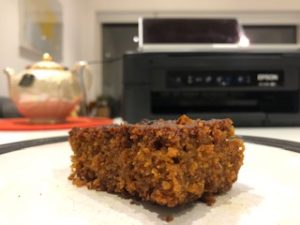Samali: a traditional Greek mastic-flavoured cake
The 25th of March is a national holiday in Greece. To celebrate, I have baked a samali, a delicious traditional Greek cake, made with semolina (instead of flour), flavoured with ground mastic, and soaked in syrup.
Greeks celebrate today for two reasons: a religious (the Feast of Annunciation to the Virgin Mary), as well as a historical one (the starting date of the Revolution or War of Independence, which led to the establishment of the Modern Greek state in 1830).
In fact, this year marks the 200-year anniversary of the declaration of the Revolution against the Ottomans, who had occupied Greece since the 15th century.
The 400-hundred Ottoman rule has deeply affected the Greek psyche, in a similar way that early life experiences affect one’s psyche throughout their lives.
But, it has also affected the Greek cuisine, which has incorporated Ottoman influences and therefore shares many similarities with the Turkish and Middle Eastern cuisines. In fact, samali is considered ‘politiko’, i.e. from the Greeks (formerly) residing in Constantinople (Istanbul).
Samali is very similar to another Greek cake: ravani or revani. The main difference is that samali does not have eggs, whereas ravani does not have mastic.
Traditionally, samali is made with semolina, sugar, yoghurt and/or oil, is flavoured with mastic and citrus fruits, and is soaked in sugar syrup.
To make it healthier, I have substituted the sugar with honey. I have also substituted the yoghurt with kefir. To make it vegan, this can be further substituted with coconut milk or yoghurt, or even with water.

Ingredients:
Dry ingredients:
2 cups fine semolina
1 cup coarse semolina
2 teaspoons baking soda
1 teaspoon baking powder
1 teaspoon ground mastic
Zest of an orange
A pinch of salt
Wet ingredients:
1 cup of orange juice
1 cup oil
1/2 cup kefir (can be substituted with yoghurt, coconut milk, or water)
1/4 cup honey
1 teaspoon vanilla
For the syrup:
1 cup of water
1 cup honey
2 tablespoons orange juice
Method:
In a bowl, combine the dry ingredients.
In a second bowl, combine the wet ingredients.
Gradually, combine the dry ingredients into the wet ingredients.
Grease a baking tray, and transfer the mixture there. Spread evenly, and set aside for an hour.
After an hour, bake the samali in a pre-heated oven (170 degrees fan) for 50 minutes.
Once the samali goes into the oven, start making the syrup. Add the water, the honey and the orange juice into a pan, then bring to a boil. Once it starts boiling, continue cooking for another 5 minutes, then remove it from the heat.
Once the samali comes out of the oven, pour the syrup over it. Set it aside to cool.
Once the samali has cooled down, cover the tray with cling film, and turn it upside down.
After an hour, turn it over.
Serve with vanilla ice cream.
Enjoy!
Further reading
Check out my recipes for portokalopita (orange pie) and semolina halva with orange and honey.
Alex
(the hopefully-soon-to-be-Traveling-again Psychiatrist)